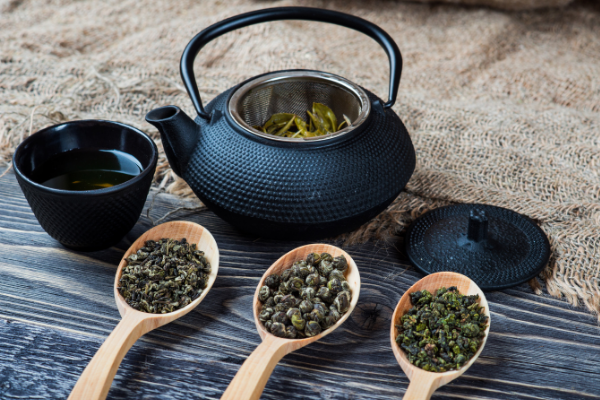

Your Complete Guide to Tea Types, Processing, Brewing Techniques, Health Benefits, and More
Tea quality begins in the field. Growing conditions such as altitude, climate, soil, and rainfall directly influence flavor, aroma, and nutrient density. High-grown teas like those from Darjeeling or the mountains of Taiwan mature slower, creating complex flavor profiles.
 Organic and Sustainable Farming
Organic and Sustainable FarmingEco-conscious cultivation reduces environmental impact while preserving the plant's integrity. Sustainable methods improve soil health, reduce pests naturally, and yield cleaner, purer tea leaves.
First flush (early spring) teas are prized for their delicate, nuanced flavors. Later flushes bring bolder profiles, with varying antioxidant levels.
| Tea Type | Flavor Profile | Caffeine | Primary Benefit |
|---|---|---|---|
| Green | Grassy, fresh | Low | Antioxidants, metabolism |
| Black | Bold, malty | High | Energy, alertness |
| Oolong | Floral, nutty | Medium | Digestion, metabolism |
| White | Delicate, sweet | Very Low | Skin health, immunity |
| Pu-erh | Earthy, rich | Medium | Gut health, detox |
| Herbal | Varies (mint, floral) | None | Sleep, digestion, relaxation |
Terroir includes the soil, altitude, weather, and surrounding flora. These shape each tea's chemical makeup and sensory characteristics. For example:
Darjeeling: Muscatel notes from misty, high-elevation slopes
Uji (Japan): Shade-grown green teas with rich umami
Yunnan: Earthy black and fermented teas, due to unique microbes in the soil
Understanding terroir adds depth to tea appreciation and guides sourcing choices.

| Stage | Duration | Temperature | Role |
| Withering | 12–14 hours | 20–25°C | Reduces moisture, activates enzymes |
| Rolling | 20–30 minutes | 25–30°C | Releases oils, shapes leaves |
| Oxidation | 1–2 hours | 25–30°C | Flavor development, color change |
| Firing | 15–20 minutes | 90–95°C | Halts oxidation, preserves tea |
The balance of these stages determines whether the tea becomes green, black, oolong, or fermented.
Polyphenols (EGCG, theaflavins): Antioxidants, anti-inflammatory
L-theanine: Calming amino acid that balances caffeine
Volatile oils: Responsible for floral, fruity, and earthy aromas
Caffeine: Boosts alertness and mental focus
These compounds make tea both a wellness drink and a sensorial experience.
Filtered, spring, or soft water is best
Avoid distilled or heavily chlorinated tap water (Using this type of water will change the taste of the tea dramatically)
| Tea Type | Temp Range | Steep Time |
| Green | 70–80°C | 1–3 min |
| White | 75–85°C | 3–5 min |
| Oolong | 85–95°C | 3–7 min |
| Black | 90–100°C | 3–5 min |
| Pu-erh | 95–100°C | 4–7 min |
| Herbal | 95–100°C | 5–8 min |
Western-style: 1 long steep
Gongfu Cha (China): Multiple short infusions
Kyusu (Japan): Side-handle pot for green teas
Grandma & Grandpa style: Leaves steeped directly in a mug, but please take out the teabag before drinking.
Experimenting with methods helps you unlock complex flavor layers.
| Factor | Loose Leaf | Tea Bags |
| Flavor | Rich, layered | Flat, one-note |
| Quality | Whole leaves | Dust/fannings |
| Brewing control | High | Low |
| Sustainability | Often reusable, bulk | Often single-use |
Loose leaf offers a more authentic experience, especially for premium teas.
 9. Choosing the Right Tea for You
9. Choosing the Right Tea for You| Goal | Recommended Tea |
| Morning Energy | Black, matcha |
| Calm Focus | Green, white |
| Gut Health | Pu-erh, oolong |
| Sleep | Chamomile, rooibos |
| Detox | Green, dandelion |
| Skin Health | White, spearmint |
Match your tea with your lifestyle and health goals.
Keep in airtight containers away from light and heat. (The containers should be glass)
Avoid moisture and strong odors (Do not store in the refrigerator, or in the freezer)
Store in a cool, dark place
Label by date and consume within 6–12 months for best taste
Chinese Gongfu Cha: Artful, mindful tea sessions
Japanese Chanoyu: Ceremonial matcha preparation
British Afternoon Tea: Social, savory, and sweet
Moroccan Mint Tea: Poured from height, symbol of hospitality
Indian Masala Chai: Spiced and simmered comfort drink
These traditions reflect tea’s cultural richness.
Water – #1 by far, essential for life.
Tea – #2 overall, and the #1 most consumed beverage after water.
Coffee – Very popular, especially in the Americas and Europe.
| Tea Type | Avg Caffeine (8 oz) |
| Black | 40–70 mg |
| Oolong | 30–50 mg |
| Green | 20–45 mg |
| White | 15–30 mg |
| Pu-erh | 30–70 mg |
| Herbal | 0 mg |
Understanding tea from leaf to cup gives you more than great taste—it deepens your connection to a global tradition rooted in wellness, nature, and mindfulness. With the right knowledge and techniques, every sip becomes an experience.
Terroir refers to the environmental conditions where tea is grown, including soil, climate, and altitude. These shape the flavor and quality of the tea leaves.
| Stage | Duration | Temperature | Role |
| Withering | 12–14 hours | 20–25°C | Reduces moisture, activates enzymes |
| Rolling | 20–30 minutes | 25–30°C | Releases oils, shapes leaves |
| Oxidation | 1–2 hours | 25–30°C | Flavor development, color change |
| Firing | 15–20 minutes | 90–95°C | Halts oxidation, preserves tea |
Tea leaves undergo four primary steps—withering, rolling, oxidation, and firing—and the degree to which each step is applied determines whether the tea becomes green, oolong, black, white, or fermented.
Withering is the first step in tea processing, where freshly plucked tea leaves are laid out to lose moisture. This softens the leaves, making them more pliable for further processing, and initiates enzymatic reactions that develop aroma and flavor compounds.
Rolling physically twists and presses the tea leaves, breaking their cellular walls and releasing essential oils. This step helps shape the tea and exposes the inner leaf juices to oxygen, which sets the stage for oxidation.
Oxidation is the chemical reaction that occurs when enzymes in the broken leaf cells interact with oxygen in the air. This changes the leaf’s color, aroma, and taste. Green tea is barely oxidized, oolong is partially oxidized, and black tea is fully oxidized.
Firing (also called drying) stops oxidation and removes residual moisture from the leaves, ensuring a stable, long-lasting product. It also contributes to the final flavor and aroma by slightly caramelizing natural sugars in the tea.
By adjusting these steps, tea artisans craft an incredible diversity of teas, each with distinct profiles and benefits.
Yes. Loose leaf teas are typically whole leaves that offer better flavor, aroma, and brewing control compared to dust-grade tea bags.
Use the right water temperature, steeping time, and tools for each tea type. Avoid boiling green or white teas, and use fresh, filtered water.
Tea offers antioxidants, amino acids like L-theanine, and anti-inflammatory compounds that support heart health, brain function, digestion, and more.
Store tea in airtight containers in a cool, dark, dry place. Avoid moisture, strong odors, and heat for long-lasting freshness.
Steep Dreams and Sassy Sips
I brew my leaves with tender care,
Then guard my mug like it’s an heir.
Green or black or oolong spree,
Don’t touch my cup—it’s just for me!
It soothes my soul, it wakes my brain,
It even helps when I complain.
No drama needed, just some peace,
A pot of tea, and stress will cease.
So if you see me with my brew,
Just grab a cup—I’ll pour for you!